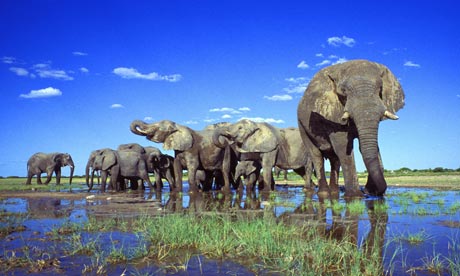NSPCA despairs over Windhoek plan to capture elephants, rhinos, cheetahs and hyaenas for national zoo near Havana

Namibia has been condemned for planning to transport a "Noah's Ark" of nearly 150 wild African animals, including elephants, rhinos, leopards, lions, antelopes and vultures to Cuba.
The national council of SPCAs (National Society for the Prevention of Cruelty to Animals) in South Africa expressed "disgust" at the neighbouring country's plan to capture the animals then fly them to the Caribbean island.
The project, dubbed "Noah's Ark II", fulfills a promise to the Cuban government in 2009 during a visit to Namibia by the country's president, Raul Castro.
The plan is to relocate the animals to Cuba's national zoological park, on the outskirts of Havana, a place that already holds captive 850 animals over 342 hectares (1.3 sq miles).
"The Namibian and Cuban governments have agreed on the translocation of 146 wild animals, valued at N$7.5m [£589,491], as a donation to Cuba," reported the newspaper Namibian. The first consignment of the 23 species, including the 'big five', will leave for Cuba early in October, while the last animals will be flown to Cuba next year."
The article added: "A group of Cuban scientists are currently in Namibia and will stay for the next two weeks to observe the capturing of the animals."
The Namibian reported that white rhinos and black rhinos would be flown out. The full list of animals to be translocated to Cuba mentions roan antelopes, common impalas, greater kudus, Cape elands, gemsbok, springbok, hartebeest, elephants, buffalos, spotted hyaenas, brown hyaenas, lions, porcupines, leopards, black-backed jackals, cheetahs, caracals, honey badgers, bat-eared foxes, ostriches, and white-backed vultures.
"It was decided, for veterinary reasons, that warthogs, waterbucks, wildebeest and zebras will not be exported to Cuba," the paper reported.
The paper quoted Netumbo Nandi-Ndaitwah, the environment and tourism minister, as saying: "The Namibian taxpayers are footing the bill for the capturing and transportation of the animals to Cuba and we will only know the exact expenditure once the project has been completed."
The government had budgeted N$25m (£2m) for the relocation of the animals in the 2011/2012 financial year, the paper added. Funds were also made available for the project for this year.
The animals will be taken from the Waterberg Plateau Park and kept in temporary enclosures before being flown out.
Nandi-Ndaitwah insisted: "This exercise is being done in accordance with the Cites requirements and we have to ensure that all animals are suitable to stay in Cuba."
The scheme is criticised by wildlife protection activists. The NSPCA in South Africa said: "[We] express disgust at the Namibian government's decision to capture animals from the wild for transportation to Cuba."
The organisation said it was concerned that the long flight would be stressful for the animals, and it questioned whether their new territory would be suitable.
The NSPCA said: "It is saddening to note that these animals will be taken out of their natural habitat and sent to a strange land where they will be deprived of freedom and be totally dependent on humans for their daily needs.
"Considering the inhumane culling of seals taking place [off] Namibia at the moment and the worldwide outcry, this latest action by the Namibian government and its ministry of environment and tourism raises serious concerns regarding this country's stance on animal welfare. Perhaps something for animal lovers to consider when considering Namibia as a holiday destination."
http://www.guardian.co.uk/world/2012/jul/10/noahs-ark-namibia-wildlife-cuba
No comments:
Post a Comment